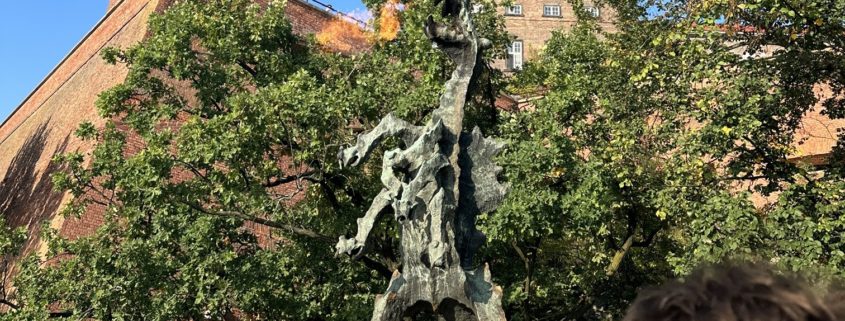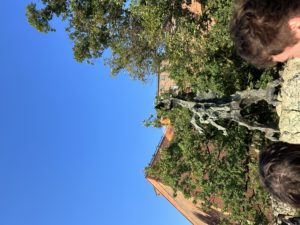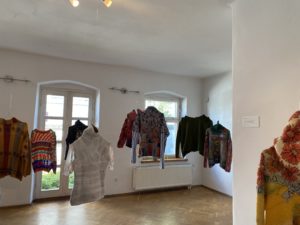What is Effective Storytelling? City Wide Fantastical Creatures Compared to the Borderland Foundation
By Maddie Hartog
When walking through Krakow, I was inclined to purchase a multi-colored stuffed dragon. I do not collect stuffed animals, nor do I love dragons, but the different colors, sizes and shapes made this dragon stuffed animal compelling to my tourist mind.
Instead of purchasing, I began questioning…
What is the story behind the Krakow dragon? Is this dragon, and other city mascots, storytelling, or is it a front to promote “storytelling”, which only leads to the insubstantial sharing of stories, and the neglect of sharing true generational hardship?
Krakow may be known for the dragon that lived beneath Wawel Hill Castle, but Wroclaw Poland, formerly Breslau Germany until 1945, is known for the mythical dwarves that line the streets. Two of Poland’s largest cities have clearly succeeded in creating mythical monuments that draw tourists to their city. Unfortunately, by solely focusing on fictional storytelling, they miss the opportunity to share community lore, and to reconstruct a communal identity, after the hardships of World War II and the Communist Era. In this paper, I will explain the creation stories of the Krakow dragon and the Wroclaw gnomes. Next, I will share how these icons have become nothing more than tourist traps and city marketing ruses meant to “share” the stories of Krakow and Wroclaw, without focusing on the underlying histories connected to these spaces. From there, I will introduce the work of the Borderland Foundation in Sejny and the film workshops that they run. This program is an alternative method of storytelling and connects the Sejny’s history to their present. Lastly, I will analyze my own personal understandings of these stories, highlighting that although Krakow and Wroclaw have compelling mythical stories, real story telling comes from sharing generational struggles in community.
Krakow’s dragon has origins dating back to the 12th century (ITS Poland). Legend has it that there was a dragon living under Wawel Hill terrorizing local residents. Many knights attempted to slay the beast. Eventually, a shoemaker tried slaying the dragon. He used a sheep filled with sulfur to tempt the dragon out of his cave, and when the dragon ate the sheep he needed water. As he was chugging the Vistula river water, the Krakow dragon exploded due to the water and sulfur mixture (ITS Poland). Nowadays, the commemorative dragon statue on the bottom of Wawel Hill is surrounded by visitors, patiently waiting to watch it breathe fire. The legend of the dragon is quite different from the history of Wroclaw’s gnomes, albeit, serving a similar purpose for the city. The gnomes seen around Wroclaw are not part of ancient history, but rather originated during the Communist Era. During the 1980s, people would use graffiti to voice their anti-Communist ideals. The police would then cover up these graffiti with white paint, as they were considered treason. When artist “Major” Fydrych realized this, he began to draw dwarves in places where anti-Communist graffiti had been covered. In this action, Fydrych is instigating a conversation with the police where they question what they should do with the dwarf. From this artistic maneuver, anti-Communists would then use manifestations of surrealism to their advantage. The dwarf became the mascot of the Orange resistance movement. Additionally, they would do other absurdist movements, like giving out products that were hard to find in Communist Poland. For example, at an anti-Communist protest, people would hand out tampons to symbolize the oppression that they faced. However, by 2005, anti-Communist gnomes began to lose their meaning when the city of Wroclaw needed a tourist grab. At this moment the city was able to commission gnomes, and now tourists come to the city looking for these gnomes. Sadly, their creation story is all but lost, and only accessible for the few who strive to find the history of the gnomes (Cervinkova 2013).
Sejny, located in the northeast corner of Poland on the Lithuanian border, has no mythical creatures on the streets; nor do you see lots of people walking or children playing. It is a much smaller, more desolate town, yet one with stories that deserve to be shared. Each of Sejny’s stories gives insight to the realities of war divided Poland, and the population of Sejny itself. Upon stepping into a former Yeshiva, which has now been repainted yellow, we were met by a Borderland Foundation worker, who has made it her mission to share the stories of Sejny: both familial and folktales. Although Borderlands has done this in eight important ways, in this space we learned about two: knitting and film. Our guide walked us into the building where she showed us a gallery. This gallery was a small room with lots of windows and sweaters hanging from the ceiling by invisible threads. On each of these sweaters, there are faces of people, images of caskets and names. Our guide was able to share the story behind each sweater and they each related to Sejny. For example, when you first walked into the room, you were confronted by two big sweaters and three tiny sweaters for children. Each sweater had a name sewed on it. This was in memory of five Jewish refugees who were forced to leave Sejny due to Anti-Semitism (Borderland Foundation 2023). This art form, although less blunt than a dragon, is much more productive for sharing stories because it prompts questioning, curiosity, and a desire to learn. The stories behind these sweaters are not obvious, or thrown in one’s face. Therefore, to truly learn, one must ask questions, and one must be willing to put themselves out there, instead of just remarking on the comical nature of a dragon that breathes fire or a gnome doing laundry in the river.
After viewing the knitted works, we moved downstairs to see the second form of storytelling: movies. In the downstairs movie theater, our host talked to us about how they run workshops for people of all ages to share stories from Sejny’s past. This process often takes up to three years and consists of; a brainstorming phase, deciding the best way to present them, and ultimately filming them and showing them to a larger audience. The Borderland Foundation supports local people through every step in hopes to “connect families” and “restore communal memory” (Borderland Foundation 2023).
Our first movie was titled “The Grand Piano,” which is a family story told by an older woman and depicted using claymation. This three minute movie opens with a young girl from Sejny playing the piano, and the narrator says that on this night, a German guard during World War II, knocked on their door reminding them of the blackout. When the German guard approaches their door, the clay characters hide. Then the German guard spots the grand piano and remarks on how he is a musician even asking to play. From there, time passes, and the German guard continues to come and play; however, he is eventually sent to the Eastern front of the war. The movie ends with the young person playing and slowly aging while sitting at the same piano. This film shares a genuine story of the war, and the hardships that were faced during the war. In the film, the narrator remarks on how her aunt was married to a Jewish man who was hiding from the Nazi’s, and that they were fearful of letting a German into their home for that reason and for the reason that their neighbors may look down upon them for being Nazi collaborators. This story showcases levels of emotion that are impossible to achieve through looking at a mythical fairytale. In fact, as an onlooker one feels a deep connection to this story as it is a woman choosing to share her own story about things that have happened in the place we are visiting.
The second story that I am choosing to highlight for you today is another story told by a young person. In this story, the narrator says that she “grew up hearing this story”. This story is a tale of the Jews in Sejny. In this tale, Sejny is a Dominican city with very few outsiders in it. However, the city was struggling to grow and survive, and so they invited in their Jewish neighbors who were in need of a home. With them, the narrator says they brought economic success and culture to Sejny. At the end of the film, the Jews are forced to migrate, leaving behind the city which they largely created. However, the narrator highlights that Jewish groups in Sejny are remembered even though they themselves do not live there anymore. Furthermore, this shows the way stories are internalized and passed down, as although Jewish people have not lived in Sejny for many years, they are remembered through Sejny residents and their memories are kept alive. Without the ability to see Jewish people, and to see the Sejny being founded, students are able to still understand the history of a place as they come together and learn about the people that lived there and the stories behind them.
What we experienced in the Borderland Foundation’s outpost in Sejny could not be more different from the creatures in Krakow and Wroclaw. In Sejny, there is productive storytelling that families get involved in together and that community members come together to watch. None of these stories have been appropriated to increase tourism. In fact, from walking around Sejny, it felt as though there are hardly ever any tourists there, and they do not seek to change that. Instead, they seek to educate those who want to learn about the history of their town, and on the microcosm of a melting pot that is this small part of the world. Unlike the dragon and the gnomes, these stories are told to increase familial cohesiveness and intergenerational connection, and to bring life back to Sejny by acknowledging shared history and trauma. What is occurring in Sejny, through genuine storytelling, makes the viewer and listener think, laugh and connect to the people telling the story. For the dragon in Krakow or the gnomes in Wroclaw, they have been taken out of context, and their origin stories have morphed and changed for the purpose of engaging tourists and children. Therefore, unless you are seeking to learn more, you will not.
Both Krakow and Wroclaw use their magical mascots in the same way: to draw in tourists. As an outcome, the cities lose the opportunities to explore other chapters in their history tied to World War II and the Communist Era. Krakow lost nearly its entire Jewish population and is still coming to terms with these absences. Wroclaw was marked by border changes and population transfers; streets were renamed, pre-war monuments were destroyed and German was erased from public spaces. There are many stories yet to tell. The Borderlands Foundations has focused on storytelling through the lens of film and children’s educational programs that capture shared history, instead of through mythical touristic sculptures. This has ultimately created real connections between generations of people living in Sejny. It has also made tourists more empathetic and eager to learn these stories as they feel connected to the people, and to their history and livelihoods, instead of drawn to caricatures and fantasies. It is easy to fall for the traps of the mythical creatures as they are light and engaging and easily accessible for tourists like myself. Yet, upon a closer look, they are not genuine stories, nor are they what I would like to remember about these places and my time there. Instead, hearing from real people – families and individuals – about the way that the community has come together, partnering with foundations and each other to keep memories alive, feels much more exciting and transformational. It is a genuine and inclusive way to learn and can be very appealing to a tourist who is intellectually curious. The Polish people have been through a lot in the 20th century, and by solely looking at gnomes or the dragon, many of these stories are lost. In contrast, coming together through storytelling that encourages genuine conversation and understanding, can connect people and enable reconciliation and a more positive future.
Works Cited
- Bartos. Walking Tour Around Krakow, Poland. September 26, 2023.
- Borderland Foundation. Sejny, Poland. September, 2023.
- Cervinkova, Hana. “The Kidnapping of Wroclaw’s Dwarfs the Symbolic Politics of Neoliberalism in Urban East-Central Europe.” Core. 2013.
- “Smok Wawelski (the Dragon of Wawel) – Its Poland.” ITS. Accessed 8 Oct. 2023.






